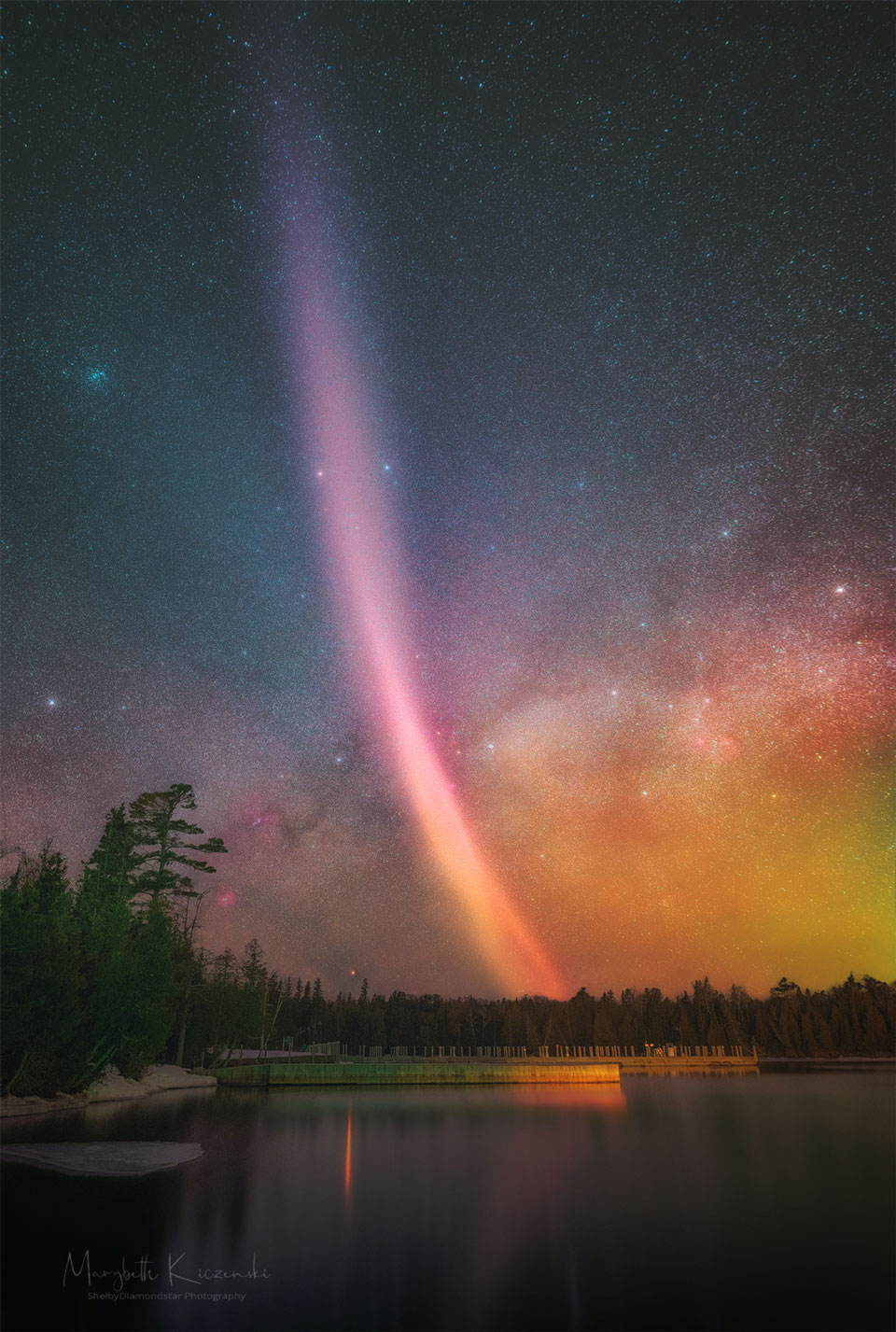Strong Thermal Emission Velocity Enhancements (STEVEs) have likely been seen since antiquity, but only in the past five years has it been realized that their colors and shapes make them different from auroras. Seen as single bright streaks of pink and purple, the origin of STEVEs remain an active topic of research. STEVEs may be related to subauroral ion drifts (SAIDs), a supersonic river of hot atmospheric ions. For reasons currently unknown, STEVEs are frequently accompanied by green “picket-fence” auroras. The featured STEVE image is a combination of foreground and background exposures taken consecutively in mid-March from Copper Harbor, Michigan, USA. This bright STEVE lasted several minutes, spanned from horizon to horizon, and appeared in between times of normal auroras.

see full post...
Stanley Cowell (May 5, 1941 – December 17, 2020) was an American jazz pianist and co-founder of the Strata-East Records label. Cowell was born in Toledo, Ohio. He began playing the piano around the age of four, and became interested in jazz after seeing Art Tatum at the age of six. Tatum was a family friend.
After high school, Cowell studied at Oberlin College and received a graduate degree in classical piano from the University of Michigan. During his time at college he played with jazz multi-instrumentalist Roland Kirk, which proved to be formative for the pianist. He moved to New York in the mid-1960s.
Cowell played with Marion Brown, Max Roach, Bobby Hutcherson, Clifford Jordan, Harold Land, Sonny Rollins and Stan Getz. Cowell played with trumpeter Charles Moore and others in the Detroit Artist’s Workshop Jazz Ensemble in 1965–66.
In 1971, Cowell founded the record label Strata-East together with trumpeter Charles Tolliver. The label would become one of the most successful Black-led, independent labels of all time.
During the late 1980s, Cowell was part of a regular quartet led by J.J. Johnson. Cowell taught in the Music Department of the Mason Gross School of the Arts at Rutgers University in New Jersey. On December 17, 2020, Cowell died at Bayhealth Hospital in Dover, Delaware, from hypovolemic shock. He was 79 years old.
https://www.youtube.com/watch?v=hEG2HHAVqPg
see full post...Edward “Kidd” Jordan (born May 5, 1935) is an American jazz saxophonist and music educator from New Orleans, Louisiana.
After completing a music degree at Southern University in Baton Rouge, he relocated to New Orleans. He taught at Southern University at New Orleans from 1974 to 2006.
Jordan was born in Crowley, Louisiana, and was raised during the time when rice farming was the predominant economic activity in the area. Jordan has noted that the music in southwestern Louisiana was “strictly Zydeco and Blues from way around, and that’s what I came up listening to.” Zydecomusician Clifton Chenier hailed from the same area, as did tenor saxophonist Illinois Jacquet (whose music teacher also instructed Jordan).
Jordan’s first instruments were C-melody and alto saxophones.[ While in high school, Jordan began performing “stock arrangements for three or four saxophones” with some older musicians, and immersed himself in the music of Charlie Parker. Jordan read transcribed solos in Down Beatmagazine but also learned Parker’s music by ear. He credits Illinois Jacquet with first giving him the idea of playing free improvisation, but was more profoundly affected by the free jazz of Ornette Coleman (who had previously performed in the area with blues bands).
Jordan majored in music education at Southern University, attending the school at the same time as Alvin Batiste (his brother-in-law). He originally planned to become a classical alto saxophonist. He moved to New Orleans in 1955, and began playing frequent R&B gigs with musicians such as Guitar Slim, Ray Charles, Big Maybelle, Big Joe Turner, Chuck Willis (with George Adams on baritone) and Choker Campbell. Jordan has described these gigs as being “satisfying for me, because there was a feeling that you’d get from dealing with that. I’ve played with some of the great female vocalists, from Gladys Knight to Aretha Franklin, or Big Maybelle, Little Esther, Lena Horne, and there’s an aesthetic in dealing with those people that a whole lot of people don’t get to. And the aesthetic from the Blues is a part of the thing that I want to have in my playing. I don’t care how out it gets.”
Jordan performs on tenor, baritone, soprano, alto, C-melody and sopranino saxophones, as well as contrabass and bass clarinets. He has indicated a preference for playing “outside” music (for example, free improvisation) on tenor, because he closely associates the alto with his earlier study of classical repertoire, tone, and technique.[3] Jordan has performed and recorded with a wide selection of musicians in styles ranging from R&B to avant-garde jazz, including Ray Charles, Stevie Wonder, R.E.M., William Parker, Alvin Fielder, Archie Shepp, Fred Anderson, Ornette Coleman, Ellis Marsalis, Cannonball Adderley, Ed Blackwell, and Cecil Taylor. In 2008, he was awarded a lifetime recognition honor by the Vision Festival.
see full post...Blind Willie McTell (born William Samuel McTier; May 5, 1898 – August 19, 1959) was a Piedmont blues and ragtime singer and guitarist. He played with a fluid, syncopated fingerstyle guitar technique, common among many exponents of Piedmont blues. Unlike his contemporaries, he came to use twelve-string guitarsexclusively. McTell was also an adept slide guitarist, unusual among ragtime bluesmen. His vocal style, a smooth and often laid-back tenor, differed greatly from many of the harsher voices of Delta bluesmen such as Charley Patton. McTell performed in various musical styles, including blues, ragtime, religious music and hokum.
McTell was born in Thomson, Georgia. He learned to play the guitar in his early teens. He soon became a street performer in several Georgia cities, including Atlanta and Augusta, and first recorded in 1927 for Victor Records. He never produced a major hit record, but he had a prolific recording career with different labels and under different names in the 1920s and 1930s. In 1940, he was recorded by the folklorist John A. Lomax and Ruby Terrill Lomax for the folk song archive of the Library of Congress. He was active in the 1940s and 1950s, playing on the streets of Atlanta, often with his longtime associate Curley Weaver. Twice more he recorded professionally. His last recordings originated during an impromptu session recorded by an Atlanta record store owner in 1956. McTell died three years later, having suffered for years from diabetes and alcoholism. Despite his lack of commercial success, he was one of the few blues musicians of his generation who continued to actively play and record during the 1940s and 1950s. He did not live to see the American folk music revival, in which many other bluesmen were “rediscovered”.
McTell’s influence extended over a wide variety of artists, including the Allman Brothers Band, who covered his “Statesboro Blues“, and Bob Dylan, who paid tribute to him in his 1983 song “Blind Willie McTell“, the refrain of which is “And I know no one can sing the blues like Blind Willie McTell”. Other artists influenced by McTell include Taj Mahal, Alvin Youngblood Hart, Ralph McTell, Chris Smither, Jack White, and the White Stripes.
see full post...John Dee Holeman, one of the leading performers of Piedmont blues, died on April 30, 2021 in Roxboro, North Carolina.
Guitarist, singer-songwriter and dancer John Dee Holeman was born on April 4, 1929 in Hillsborough, North Carolina and lived for many years in Durham, North Carolina.
During his early years, Holeman played at local parties and other events. Later, he moved to Durham and started playing electric guitar with pianist Fris Holloway. Both artists became well known for doing the Juba dance (complex hand rhythms that accompany dancers).
see full post...
The Fox Fur Nebula is a nebula (a formation of gas and dust) located in the constellation of Monoceros (the Unicorn) not far off the right arm of Orion and included in the NGC 2264 Region. In the Sharpless catalog it is number 273. The image is a close-up of a small section of a much larger complex, generally known as the Christmas Tree cluster. The Cone Nebula is also a part of this same cloud. The red regions of this nebula are caused by hydrogen gas that has been stimulated to emit its own light by the copious ultraviolet radiation coming from the hot, blue stars of the cluster. The blue areas shine by a different process: they are mainly dust clouds that reflect the bluish light of the same stars. Its popular name arises because the nebula looks like the head of a stole made from the fur of a red fox.

Ronald Levin Carter (born May 4, 1937) is an American jazz double bassist. His appearances on 2,221 recording sessions make him the most-recorded jazz bassist in history. Carter has two Grammy awards. Carter is also a cellist who has recorded numerous times on that instrument. Some of his studio albums as a leader include: Blues Farm (1973); All Blues (1973); Spanish Blue (1974); Anything Goes (1975); Yellow & Green(1976); Pastels (1976); Piccolo (1977); Third Plane (1977); Peg Leg (1978); A Song for You (1978); Etudes (1982); The Golden Striker (2003); Dear Miles (2006); Ron Carter’s Great Big Band (2011).
Carter was born in Ferndale, Michigan. He started to play cello at the age of 10, and switched to bass while in high school. He earned a B.A. in music from the Eastman School of Music (1959) and a master’s degree in music from the Manhattan School of Music (1961).
Carter’s first jobs as a jazz musician were playing bass with Chico Hamilton in 1959, followed by free-lance work with Jaki Byard, Cannonball Adderley, Randy Weston, Bobby Timmons, and Thelonious Monk. One of his first recorded appearances was on Hamilton alumnus Eric Dolphy‘s Out There, recorded on August 15, 1960, and featuring George Duvivier on bass, Roy Haynes on drums, and Carter on cello. The album’s advanced harmonies and concepts were in step with the third stream movement. In early October 1960, Carter recorded How Time Passes with Don Ellis, and on June 20, 1961, he recorded Where?, his first album as a leader, featuring Dolphy on alto sax, flute, and bass clarinet, Mal Waldron on piano, Charlie Persip on drums, and Duvivier playing bass lines on tracks where Carter played cello.
https://www.youtube.com/watch?v=asJRAGUlZ1c
see full post...Walter Maynard Ferguson CM (May 4, 1928 – August 23, 2006) was a Canadian jazz trumpeter and bandleader. He came to prominence in Stan Kenton‘s orchestra before forming his own big band in 1957. He was noted for his bands, which often served as stepping stones for up-and-coming talent, his versatility on several instruments, and his ability to play in a high register. Ferguson was born in Verdun (now part of Montreal), Quebec. Encouraged by his mother and father (both musicians), he started playing piano and violin at the age of four. At nine years old, he heard a cornet for the first time in his local church and asked his parents to buy one for him. When he was thirteen, he soloed with the Canadian Broadcasting Corporation Orchestra. He was heard frequently on the CBC, notably featured on a “Serenade for Trumpet in Jazz” written for him by Morris Davis. He won a scholarship to the Conservatoire de musique du Québec à Montréal where he studied from 1943 to 1948 with Bernard Baker.
see full post...Umm Kulthum (Arabic: أم كلثوم, Egyptian Arabic: [ˈomme kælˈsuːm]; French: Oum Kalthoum; born Fāṭima ʾIbrāhīm es-Sayyid el-Beltāǧī فاطمة إبراهيم السيد البلتاجي on 31 December 1898, or 4 May 1904; died 3 February 1975) was an Egyptian singer, songwriter, and film actress active from the 1920s to the 1970s. She was given the honorific title Kawkab al-Sharq (كوكب الشرق, ‘Star of the East’). Umm Kulthum was known for her vocal ability and unique style. She sold over 80 million records worldwide, making her one of best-selling singers of all time from the Arab world.
She is considered a national icon in her native Egypt; she has been dubbed “The voice of Egypt” and “Egypt’s fourth pyramid”.
see full post...Tyagaraja (4 May 1767 – 6 January 1847), also known as Tyāgayya, was a renowned composer of Carnatic music, a form of Indian classical music. He was prolific and highly influential in the development of India’s classical music tradition. Tyagaraja and his contemporaries, Shyama Shastri and Muthuswami Dikshitar, are regarded as the Trinity of Carnatic music. Tyagaraja composed thousands of devotional compositions, most in Telugu and in praise of Lord Rama, many of which remain popular today. Of special mention are five of his compositions called the Pancharatna Kritis (English: “five gems”), which are often sung in programs in his honour.
Tyagaraja saw the reigns of four kings of the Maratha dynasty — Tulaja II (1763–1787), Amarasimha (1787–1798), Serfoji II (1798–1832) and Sivaji II(1832–1855), although he served none of them.
see full post...This detailed image features Abell 3827, a galaxy cluster that offers a wealth of exciting possibilities for study. It was observed by Hubble in order to study dark matter, which is one of the greatest puzzles cosmologists face today. The science team used Hubble’s Advanced Camera for Surveys (ACS) and Wide Field Camera 3 (WFC3) to complete their observations. The two cameras have different specifications and can observe different parts of the electromagnetic spectrum, so using them both allowed the astronomers to collect more complete information. Abell 3827 has also been observed previously by Hubble, because of the interesting gravitational lens at its core. Looking at this cluster of hundreds of galaxies, it is amazing to recall that until less than 100 years ago, many astronomers believed that the Milky Way was the only galaxy in the Universe. The possibility of other galaxies had been debated previously, but the matter was not truly settled until Edwin Hubble confirmed that the Great Andromeda Nebula was in fact far too distant to be part of the Milky Way. The Great Andromeda Nebula became the Andromeda Galaxy, and astronomers recognised that our Universe was much, much bigger than humanity had imagined. We can only imagine how Edwin Hubble — after whom the Hubble Space Telescope was named — would have felt if he’d seen this spectacular image of Abell 3827.

James Joseph Brown (May 3, 1933 – December 25, 2006) was an American singer, songwriter, dancer, musician, record producer, and bandleader. The central progenitor of funk music and a major figure of 20th-century music, he is often referred to by the honorific nicknames “Godfather of Soul”, “Mr. Dynamite”, and “Soul Brother No. 1”. In a career that lasted over 50 years, he influenced the development of several music genres. Brown was one of the first ten inductees into the Rock and Roll Hall of Fame at its inaugural induction in New York on January 23, 1986.
Brown began his career as a gospel singer in Toccoa, Georgia. He came to national public attention in the mid-1950s as the lead singer of the Famous Flames, a rhythm and blues vocal group founded by Bobby Byrd. With the hit ballads “Please, Please, Please” and “Try Me“, Brown built a reputation as a tireless live performer with the Famous Flames and his backing band, sometimes known as the James Brown Band or the James Brown Orchestra. His success peaked in the 1960s with the live album Live at the Apollo and hit singles such as “Papa’s Got a Brand New Bag“, “I Got You (I Feel Good)” and “It’s a Man’s Man’s Man’s World“.
During the late 1960s, Brown moved from a continuum of blues and gospel-based forms and styles to a profoundly “Africanized” approach to music-making, emphasizing stripped-down interlocking rhythms that influenced the development of funk music. By the early 1970s, Brown had fully established the funk sound after the formation of the J.B.s with records such as “Get Up (I Feel Like Being a) Sex Machine” and “The Payback“. He also became noted for songs of social commentary, including the 1968 hit “Say It Loud – I’m Black and I’m Proud“. Brown continued to perform and record until his death from pneumonia in 2006.
Brown recorded 17 singles that reached No. 1 on the Billboard R&B charts. He also holds the record for the most singles listed on the BillboardHot 100 chart that did not reach No. 1. Brown was inducted into the first class of the Rhythm & Blues Music Hall of Fame in 2013 as an artist and then in 2017 as a songwriter. He also received honors from several other institutions, including inductions into the Black Music & Entertainment Walk of Fame, and the Songwriters Hall of Fame. In Joel Whitburn‘s analysis of the Billboard R&B charts from 1942 to 2010, Brown is ranked No. 1 in The Top 500 Artists.He is ranked seventh on Rolling Stone‘s list of the 100 Greatest Artists of All Time.
see full post...James Milton Cleveland (May 3, 1926 – August 23, 2008) was an American jazz trombonist born in Wartrace, Tennessee.
Cleveland was signed by EmArcy Records in 1955. Cleveland was married to jazz vocalist Janet Thurlow. He died on August 23, 2008, in Lynwood, California, at the age of 82.
see full post...John Aaron Lewis (May 3, 1920 – March 29, 2001) was an American jazz pianist, composer and arranger, best known as the founder and musical director of the Modern Jazz Quartet.
John Lewis was born in La Grange, Illinois, and after his parents’ divorce moved with his mother, a trained singer, to Albuquerque, New Mexico when he was two months old. She died from peritonitis when he was four and he was raised by his grandmother and great-grandmother. He began learning classical music and piano at the age of seven. His family was musical and had a family band that allowed him to play frequently and he also played in a Boy Scout music group. Even though he learned piano by playing the classics, he was exposed to jazz from an early age because his aunt loved to dance and he would listen to the music she played. He attended the University of New Mexico, where he led a small dance band that he formed and double majored in Anthropology and Music.
see full post...Peter Seeger (May 3, 1919 – January 27, 2014) was an American folk singer and social activist.
A fixture on nationwide radio in the 1940s, Seeger also had a string of hit records during the early 1950s as a member of the Weavers, most notably their recording of Lead Belly‘s “Goodnight, Irene“, which topped the charts for 13 weeks in 1950. Members of the Weavers were blacklisted during the McCarthy Era. In the 1960s, Seeger re-emerged on the public scene as a prominent singer of protest music in support of international disarmament, civil rights, counterculture, workers’ rights, and environmental causes.
A prolific songwriter, his best-known songs include “Where Have All the Flowers Gone?” (with additional lyrics by Joe Hickerson), “If I Had a Hammer (The Hammer Song)” (with Lee Hays of the Weavers), “Kisses Sweeter Than Wine” (also with Hays), and “Turn! Turn! Turn!“, which have been recorded by many artists both in and outside the folk revival movement. “Flowers” was a hit recording for the Kingston Trio (1962); Marlene Dietrich, who recorded it in English, German and French (1962); and Johnny Rivers (1965). “If I Had a Hammer” was a hit for Peter, Paul and Mary (1962) and Trini Lopez (1963) while the Byrds had a number one hit with “Turn! Turn! Turn!” in 1965.
Seeger was one of the folk singers responsible for popularizing the spiritual “We Shall Overcome” (also recorded by Joan Baez and many other singer-activists), which became the acknowledged anthem of the Civil Rights Movement, soon after folk singer and activist Guy Carawan introduced it at the founding meeting of the Student Nonviolent Coordinating Committee (SNCC) in 1960. In the PBS American Masters episode “Pete Seeger: The Power of Song“, Seeger said it was he who changed the lyric from the traditional “We will overcome” to the more singable “We shall overcome”.
see full post...